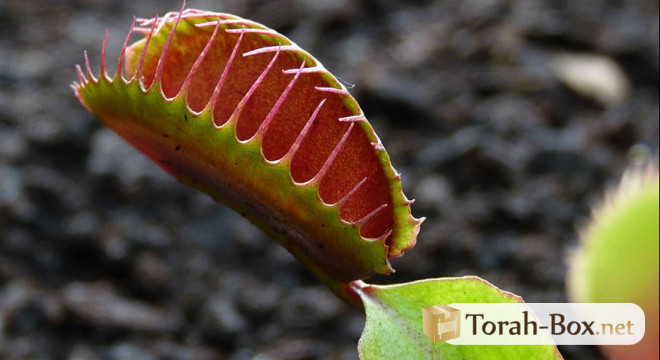
Torah & Science
Darwin and the Carnivorous Plant
It is said that when Darwin observed a carnivorous plant trapping flies, he was very surprised. But in truth, there is nothing surprising about that. At the end of each of this plant's leaves, there is a light pink opening, which contains some nectar. The insect is attracted by either the color or the nectar, and is subsequently trapped inside.
The opening consists of two lamellae articulated by an axis. At the end of these lamellae is a series of very sharp teeth. The carnivorous plant waits until the insect penetrates inside and touches its sensory hairs that are in the inner part of the lamellae. These hairs give the slats an order to close, and they close around the axis very quickly. At this point, the teeth intertwine to prevent the insect from escaping. There are three sensory hairs and touching only one of the hairs produces no reaction on the part of the plant. Once the insect has been seized, the plant begins to produce a liquid that putrefies the insect and makes it edible for the plant.
Darwin was very impressed by the speed of movement with which the plant closed. He characterized it as one of the most fabulous plants in the world. But, like a blind man who sees nothing and does not understand what is happening, he was not able to draw the necessary conclusions. He merely qualified his observation as "progressive adaptation" or "survival instinct". Darwin's followers have called this wonderful mechanics a "mutant plant". In the same way, one can qualify a typewriter as a "mutant pen" (that is, a pen that has undergone evolutionary mutations).
In order to seize the insect and eat it, the carnivorous plant needs the optimum conditions: an attractive color, nectar, two lamellae, the mechanism of the pivoting axis, and removable teeth (without these, the insect could escape when the slats close). The plant also has sensory hairs that are in direct contact with the lamellae to operate the trap. The insect must touch at least two hairs to be able to operate the trap, this avoids the plant closing unnecessarily when tiny objects penetrate between the slats. The plant also has special digestive juices that can swallow parts of the insect. After the insect is captured, the lamellae remain closed for several days until the insect is completely digested. Then, the trap opens again to capture the next prey.
Each of the components for the proper functioning of the trap is in itself a complex mechanism. If only one component is missing, the other components are no longer needed. Each element must work perfectly from the beginning, otherwise it may slow down the plant, like part of the body that does not work. A plant organism in such a situation cannot survive according to the rules of evolution.
Those who hold by the notion that the world was created "according to the theory of evolution" find themselves stuck at a dead end. The mutation of this plant that captures insects is an enigma. This plant should have been created complete to be able to function perfectly without having to feed on insects. This fact, as well as all the other manifestations of the plant and the animal world, clearly announce their objective!
Sorry, but those who wanted to demonstrate that this world is not led by a Creator cannot do so in the face of such obvious truths (Darwin was originally a student of theology, but he rejected his religion and objected the notion of religion). They have established completely foolish theories to justify their behavior, preaching obscure ideas, provided that they do not need to recognize the existence of a Creator who directs all the wonders of the world and the inexhaustible treasures of nature.
Torah-Box.net Account
To access the entire Torah-Box.net website, sign up for free in less than a minute.
Shabbat Times
 Candle Lighting - New York
Candle Lighting - New York
Friday April 18th, 2025 at 19:20 *Shabbat ends at 20:23 *
change my location
* Times given as an indication, check the times of your community











